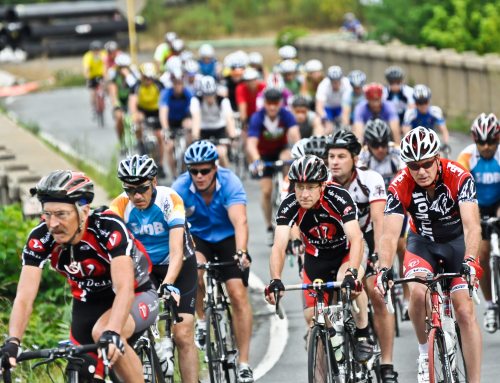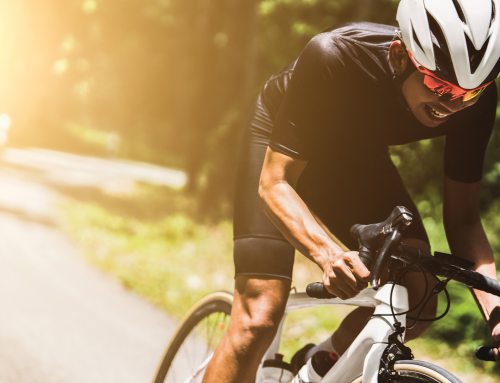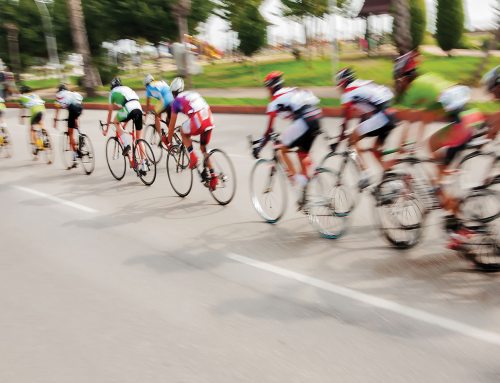By Thomas Henson Jr.
I hate traffic. Whether I’m on a bike or in my car, there’s a part of me that wishes I had a private roadway all to myself so I didn’t have to be so hyper-aware, so defensive, and so, well…irritated. When you’re walled-in by motorists, defensiveness and awareness are beneficial. Irritation, however, can seriously cloud your mind. And on a bike, lack of focus can easily lead to injury.
The first trick to cycling safety in traffic is to remember what it’s like to be a motorist in traffic. There’s that feeling of claustrophobia, like you’re never going to go anywhere because you’re hemmed in on all sides by other cars. Unfortunately for those of us on our bikes, motor vehicle drivers in traffic are focused on their own frustrations—how late they will be for work, or whether they will have time to stop at the grocery store before heading home to make dinner. They are not likely to be watching for the cyclist who comes cruising up on the shoulder.
Worse, they may take out their road rage on you. Earlier this year, a Kansas motorist was charged with aggravated battery after he pulled in front of cyclist, slammed on his brakes and caused a collision…then turned and hit the bike again. The cyclist was severely injured, but lived. It was reported that the driver was irritated at having to wait at a stop sign while the cyclist passed him by. The scariest part of this story: Despite eyewitness testimony, the jury found the motorist not guilty (although the cyclist was able to get a positive verdict in a civil lawsuit). Road rage is real, folks.
While cyclists in North Carolina have the same rights and responsibilities as other vehicles on the road, you cannot control the actions of others. In any car-meets-bicycle accident, the cyclist will always be the physical loser. Despite road rules, it’s up to you to minimize the opportunities for a collision. Always assume that drivers won’t see you, or won’t make room for you. That means:
- Follow the rules of the road. This is the single most important thing you can do to limit your risk. Motorists are trained to watch for predictable patterns in roadway traffic, and they need cues about what cyclists are doing. So, stop at stoplights and signs, use hand signals when turning, stay in your lane, and ride with the flow of traffic.
- Don’t give in to your own road rage. That car may have come too close for comfort, but hitting your hand on the side of the vehicle will only escalate the problem. Keep your cool for your own safety.
- Limit foul-weather training. If you think that riding in traffic in dappled sunlight is tough, riding in a rainstorm is nearly impossible. Roads become slick, fog hampers visibility, rain pelts your face, and car tires kick up debris. If possible, put off training until the weather clears.
- Hard to believe, but yes I see cyclists doing this: Don’t talk on a cell phone. Research has shown that simply talking on a phone is a distraction, and on a bike it can be disastrous. It distracts you and takes away your hands from what they should be doing – using the handlebars to steer. Save your attention for reacting to potentially dangerous driving habits of others.
- Wear high-visibility clothing. Every bike shop across the country sells enough neon-bright colored options to dress you from head to toe—hats, shirts, pants, vests, socks, shoes, jackets, gloves, and more. And don’t be afraid to mix colors—areas of high-contrast, such as a blue shirt next to yellow shorts above orange socks, will register to the eye more quickly.
- Plan your route to avoid high-traffic roads or times of day. But that doesn’t mean you can let your guard down. A friend of mine was hit on a country road by a car driven by a young woman who was late for church on a Sunday morning. (He also survived, but with several broken ribs.)
- Put flashing lights on the front and back of your bike so motorists can see you from behind and from their rear-view mirror.
- Watch for drivers exiting their cars, and ride as far out into the middle of the road as you safely can. Again, a motorist in a rush knows by habit to look for on-coming cars, but is less likely to see you and your bike.
Finally—in addition to being wary of motorists—watch for road defects, potholes, and other hazards. Any fall, regardless of cause, could land you directly in the path of traffic. Defensiveness is the best survival tool for any cyclist.
Ride Safe, and I’ll see you on the road!
# # #
Thomas Henson Jr. is an avid cyclist, and finds much happiness in bike rides with his family and friends. He leads the complex injury litigation department of HensonFuerst Attorneys. He can be contacted at ThomasHenson@lawmed.com.






